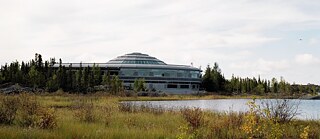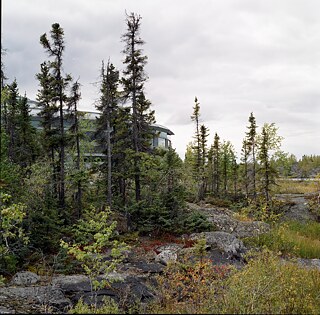German Traces in the Territories
The landscape architecture in Yellowknife

The Northwest Territories Legislative Assembly Building, located in the harsh, remote land of Canada’s North, was designed and built almost 100 years later than the other capital buildings in Canada. In response to the unique requirements for designing a new capital building, the site for the Legislative Assembly Building was carefully chosen. The idea was to incorporate the beauty of the landscape.
The architecture fits harmoniously into rock out-cropping, peat bog, and the lakeside location. Matsuzaki Wright/Pin Matthews Architects were entrusted with the conception of the building; the landscape design was assigned to Cornelia Hahn Oberlander Landscpape Architects.
Cornelia Hahn was born in Mühlheim-an-der-Ruhr, North Rhine-Westphalia, in 1921. In 1938, she fled from increasing persecution of Jews with her mother and her sister to England. A year later, the family settled in New York State. In 1944, Cornelia Hahn registered in landscape architecture at Harvard. Only in 1943 did the Harvard Graduate School of Design start to admit women, and she was one the first women. During that time, she met her future husband, Peter Oberlander, who was studying city planning there. When the University of British Columbia asked Peter to set up its School of Community and Regional Planning in 1953, the couple moved to Vancouver. In the same year, Cornelia Hahn Oberlander Landscape Architects was founded, the first landscape architecture firm in Canada.

As Canada’s premier landscape architect, Cornelia Hahn Oberlander is known for integrating her designs in the overall architectural project with the natural environment, yet always adding a unique new vision and dimension. Her expert technical knowledge is coupled with her concern for expressing cultural, social and environmental concepts in her work and is reflected in her many projects. Cornelia Hahn Oberlander has received numerous prizes and awards, including the Order of Canada in 1990.
From Picturing Landscape Architecture – Projects of Cornelia Hahn Oberlander as seen by Etta Gerdes (Mechtild Manus/Lisa Rochon)
Legislative Assembly Building
4570 48th St.
Yellowknife, NT
X1A 2L9